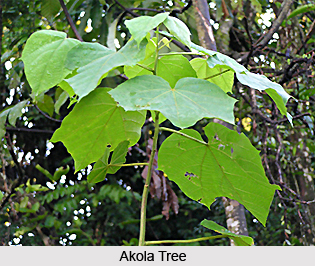 Akola is a medicinal plant widely distributed over the plains and lower areas throughout most of India. In peninsular India, the Alangiaceae plants are found near streams in dry deciduous forests, along roadsides or on fallow agricultural lands near villages. One of its species known as Alangium salvifolium subsp. hexapetalum is restricted to wet forests of the Western Ghats within India. its scientific name is Alangiaceae.
Akola is a medicinal plant widely distributed over the plains and lower areas throughout most of India. In peninsular India, the Alangiaceae plants are found near streams in dry deciduous forests, along roadsides or on fallow agricultural lands near villages. One of its species known as Alangium salvifolium subsp. hexapetalum is restricted to wet forests of the Western Ghats within India. its scientific name is Alangiaceae.
These are deciduous bushy shrubs and often considered as small trees upto 10 m tall, with or without spines. The barks are pale brown, aromatic, rough with shallow cracks, exfoliating in corky scales. Leaves of Akola plants are15 cm long which are alternate, narrowly elliptic or ovate in shape. The flowers of this plant are greenish-white in colour. Fruits are edible and ellipsoid, black, fleshy, crowned by persistent calyx with large seeds inside which are enclosed in red, mucilaginous, sweet and astringent pulp. In India, only two of its sub species are found.
Akola is, in fact, considered to be an important medicinal plant. Each and every part of this plant is used for separate medicinal purposes. The root bark, used in the form of a decoction or powder, is very bitter and credited with antipyretic, astringent, diaphoretic, pungent, purgative and emetic properties. It is a famous drug in Ayurveda, used both externally and internally for rabies and as an antidote for other poisonous bites, including snake bites. It is also used in the treatment of diarrhoea, worms, syphilis and, in the form of a paste or decoction, as an external application for leprosy, erysipelas and other skin diseases. When administered in small doses, it causes a transient drop in blood pressure followed by a sustained rise, depression of the heart and irregular respiration. It also increases the peristaltic movement of the intestines.
In Gujarat province, a decoction of the root bark is used for the treatment of dropsy. The oil derived from the root bark is applied externally for treatment of acute rheumatism. A paste prepared from the root with another herb, Tragia involucrata (Euphorbiaceae), is applied as a cure for paralysis among the Kondh people of southwestern Orissa. A paste prepared from the root bark is used as a local application to treat snake bites, cat and dog-bites in the Gandhamardan Hills of Orissa. It is also taken orally to promote excretion of toxins. The leaves are applied as a poultice to relieve rheumatism and are also considered as hypoglycaemic. The fruits of this plant are enjoy by children in India which are credited with antiphlegmatic, laxative, tonic and cooling properties, and are used for treating emaciation, haemorrhages, strangury and consumption. They are also used to prevent and cure eye troubles. The seeds are valued in traditional Indian medicine for their cooling and tonic properties and for their use in the treatment of haemorrhage.
The botanical names of Akola plant are: Alangium decapetalum Lam., A. lamarkii Thwaites, A. salvifolium subsp. decapetalum (Lam.) Wangerin and Grewia salvifolium L. f. the common names of this medicinal plant varies according to the regions of India. In Bengal they are popular as Akarkanta, Ankhura, Baghankura and Dhalakura, in Gujarat it is famous as Ankol, Ankola, Ankoli, Onkla, whereas in Hindi dominated areas this plant is famous as Akola, Anedhera, Ankol and Dheri.



















